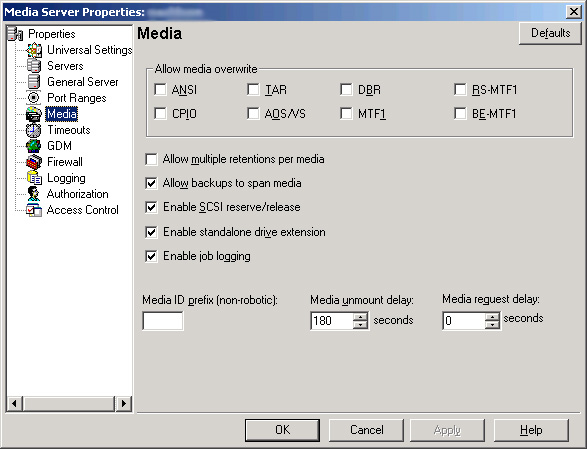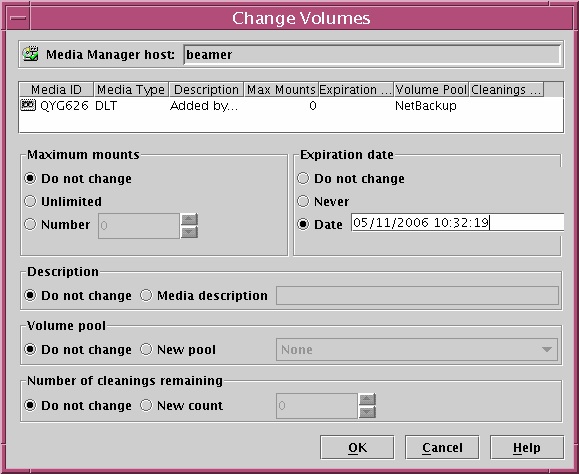Status Code:
96
Unable to allocate new media for backup,
storage unit has none available
A status 96 indicates a backup ran and found no media
available for the backup to use. The
process for selecting media considers media previously used by the media server
running the backup; new media that matches that storage unit requirements; and
if configured, a “scratch” pool for additional media.
Table of Contents
1 Expected causes of status 96 errors.................................................................................... 2
1.1 The pool specified by the backup does not have any media available for
use.................. 2
1.2 Available media is FULL, FROZEN, or SUSPENDED....................................................... 2
1.3 Incorrect retention level.................................................................................................. 3
1.4 All the qualified media are physically expired.................................................................. 4
1.5 When spanning media, there are no more available media................................................ 4
2 Error conditions which cause status code 96......................................................................... 5
2.1 Scratch pool is not properly configured.......................................................................... 5
2.2 Incorrect density in use.................................................................................................. 5
3 More information from the 6.0 troubleshooting guide............................................................. 6
1 Expected causes of status 96 errors
The majority of
status 96 errors occur for a good reason. This section covers some of those
reasons and gives suggestions how to correct the problem.
1.1 The pool specified by the backup does not have
any media available for use.
If a status 96
occurs, check to see if the correct pool is specified in the policy and confirm
the pool has tapes available for use. Keep in mind, if a tape is assigned, it
may not be available for the media server in question or the policy in
question. A good approach is to ensure there are unassigned media in the pool.
1.2 Available media is FULL, FROZEN, or SUSPENDED.
When nbemm attempts
to allocate media for a backup job, it reviews assigned media that could be
used and excludes any media that are FULL, FROZEN, or SUSPENDED. Media in these
states are not considered for backups.
To determine how
much media is in one of these three states, the media summary report for the
media server reporting the error can be used.
This provides a count of FULL, FROZEN, and SUSPENDED media. To see the media IDs associated with each
FULL, FROZEN, or SUSPENDED media, use the media list report.
1.3 Incorrect retention level
By default,
NetBackup does not allow backups with different retention levels to use the
same media. This is done to ensure
efficient tape usage. The nbemm process checks this criteria.
To override this
operation on a media server:
Go into the
NetBackup Administration Console, and under Host Properties, select Media
Server. Find the media server in the
right hand window, and double click on it.
Go to the Media section, and set the “Allow multiple retentions per
media” option.

1.4 All the qualified media are physically expired
If a volume has a
physical expiration date set in the volume database, after that date, the
volume is no longer usable for backups.
To change the expiration date of an individual media on a media server:
Go into the NetBackup
Administration Console, and under Media and Device Management, select
Media. Find the media ID for which the
expiration date needs to be changed, right-click on it, and select Change (or
double-click on the media). Set the
expiration date as required.

1.5 When spanning media, there are no more
available media
In the event a
backup fills up the selected tape, it needs to select a new one. If the nbemm
process finds no new media, the backup fails with a status 96. Either add more media to the volume pool or
add more media to the scratch pool.
2 Error conditions which cause status code 96
2.1 Scratch pool is not properly configured
For a scratch pool
to work, it must exist in the pool database, and be defined as a scratch pool
within NetBackup.
To define a pool as a scratch pool on a media server:
Go into the NetBackup
Administration Console, and under Media and Device Management, select Media,
and then Volume Pools. Create a new
volume pool and select the “Scratch Pool” option on the New Volume Pool dialog
box.
2.2 Incorrect density in use
If the density
defined in the storage unit does not match the density of the volumes as stored
in the volume database, the media is not
considered for a backup.
3 More information from the 6.0 troubleshooting
guide
NetBackup Status
Code: 96
Message: unable to allocate
new media for backup, storage unit has none available
Explanation: The nbemm could
not allocate a new volume for backups. This indicates that the storage unit has
no more volumes available in the volume pool for this backup. Note that
NetBackup will not change storage units during the backup.
Recommended
Action: Check the NetBackup Problems report to determine the storage unit that
is out of media.
1. If the storage
unit is a robot and there are empty slots, add more volumes (remember to
specify the correct volume pool).
- If there are no empty slots, move some
media to nonrobotic and then add new volumes.
- If you are having difficulty keeping
track of your available volumes, try the
available_media script:
On UNIX,
this script is in:
/usr/openv/netbackup/bin/goodies/available_media
On Windows,
the script is in:
install_path\NetBackup\bin\goodies\available_media.cmd
This script lists
all volumes in the Media Manager volume configuration, and augments that list
with information on the volumes currently assigned to NetBackup.
2. Set up a scratch
volume pool as a reserve of unassigned tapes. If NetBackup needs a new tape and
no more tapes are available in the current volume pool, NetBackup moves a tape
from the scratch pool into the volume pool that the backup is using.
3. If the storage
unit and volume pool appear to have media, verify the following: Volume is not
FROZEN or SUSPENDED Check for this condition by using the NetBackup Media List
report. If the volume is frozen or suspended, use the bpmedia command to
unfreeze or unsuspend it (if that is desired).
- Volume has not expired or exceeded its
maximum number of mounts.
- The Media Manager configuration has
media in the correct volume pool and unassigned or active media is
available at the required retention level. Use the NetBackup Media List
report to show the retention levels, volume pools, and status (active and
so on) for all volumes. Use the NetBackup Media Summary report to check
for active volumes at the correct retention levels.
4. In some
configurations, the NetBackup bptm process is rejected when requesting media
from the vmd process (UNIX) or the NetBackup Volume Manager service (Windows)
because that process or service cannot determine the name of the host that is
making the request. This can be due to incorrect network configuration involving:
- Multiple network interfaces
- /etc/resolv.conf on those UNIX systems that use it
- Running DNS and not having reverse
addressing configured
5. If this is a new
storage unit, and this is the first attempt to use it, stop and restart
NetBackup on the master server.


No comments:
Post a Comment
Note: only a member of this blog may post a comment.